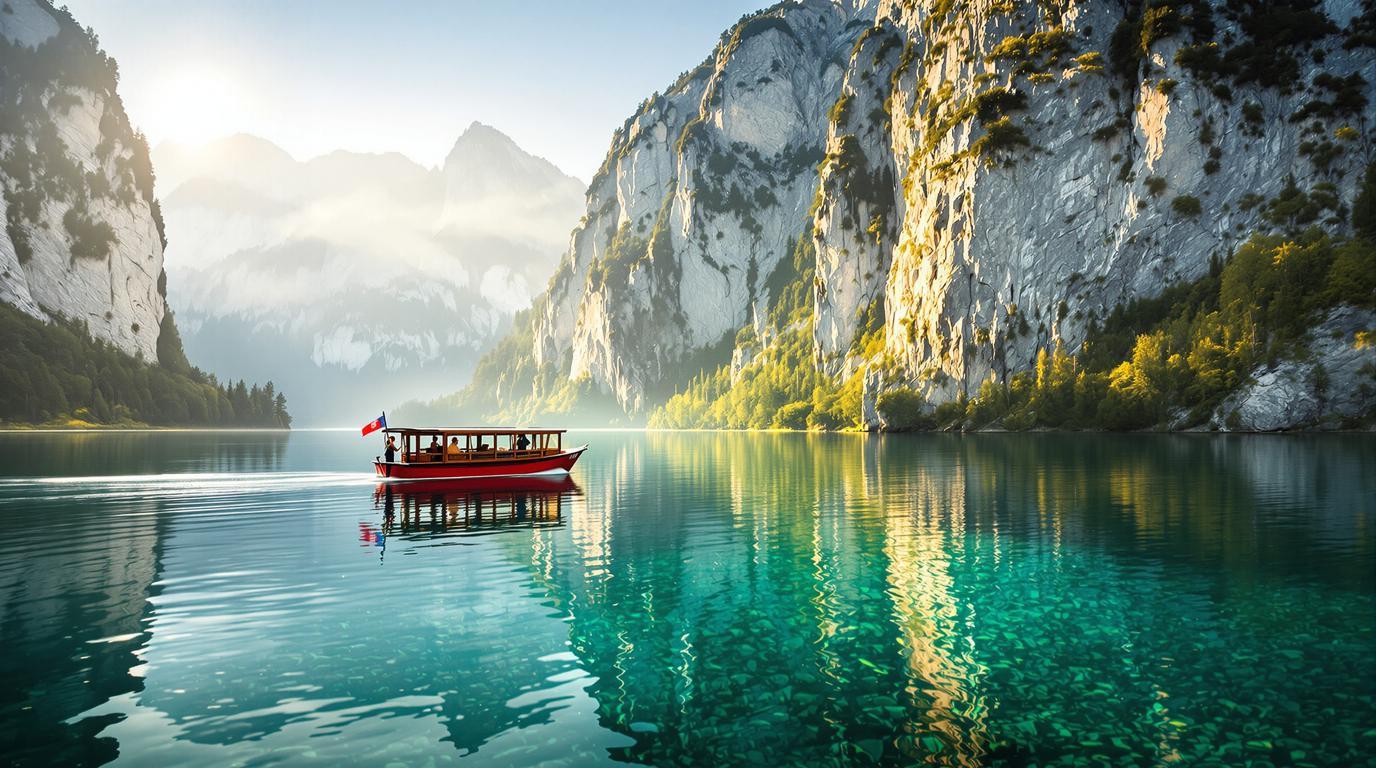Bavaria’s emerald treasure, Lake Königssee gleams like a fjord transplanted to the German Alps. Stretching 7.7 kilometers through the Berchtesgaden National Park, this pristine alpine lake has maintained its crystal-clear waters thanks to a century-old environmental protection decision: only electric boats have navigated these waters since 1909.
The fjord of Bavaria: Germany’s cleanest and deepest lake
Surrounded by towering limestone cliffs that rise dramatically from the shoreline, Königssee creates an otherworldly landscape that feels more Norwegian than German. The lake plunges to depths of 190 meters, making it Germany’s third deepest lake and arguably its most spectacular.
“The water clarity here is remarkable – sometimes reaching 20 meters of visibility,” explains Klaus Weber, a veteran boat captain who has navigated Königssee for over 25 years. “We’ve protected this environment carefully, which is why you can still drink directly from certain parts of the lake.”
The legendary echo that captivates every visitor
No visit to Königssee is complete without experiencing its most famous acoustic phenomenon. Halfway across the lake, boat captains pause to demonstrate the extraordinary echo produced by the surrounding rock walls. For over a century, they’ve played flugelhorns that send notes bouncing seven times across the water.
This natural amphitheater effect has drawn visitors since the early 19th century, though now it’s preserved as a controlled demonstration rather than the rifle shots once used to trigger the echo.
St. Bartholomä: The iconic red-domed church
The postcard-perfect St. Bartholomä Church stands as Königssee’s most photographed landmark. Dating back to the 12th century and reconstructed in its distinctive Baroque style with bright red onion domes in 1697, this pilgrimage church feels wonderfully isolated despite receiving thousands of visitors daily during summer months.
Behind the church, traditional restaurants serve fresh smoked trout caught from the lake – a culinary tradition dating back generations. Try the “schwarzreiter,” a specially prepared smoked char that takes its name from historical poachers.
Hidden gem: Obersee and Germany’s highest waterfall
Most visitors stop at St. Bartholomä, missing what locals consider Königssee’s true highlight. Continue to the southern end at Salet, then walk 15 minutes to discover Obersee, a smaller, even more pristine alpine lake nestled against vertical mountain walls.
From Obersee, ambitious hikers can continue to Röthbachfall, Germany’s highest waterfall dropping 470 meters through multiple cascades. This impressive alpine trek rewards with views few international tourists ever witness.
When to visit: The perfect alpine window
The optimal time to experience Königssee spans from May through September, with June offering the perfect balance of comfortable temperatures and smaller crowds. July and August bring stunning swimming opportunities with water temperatures reaching a surprising 20°C, though also peak tourist numbers.
Like many European natural treasures, Königssee transforms dramatically with seasons. Early mornings in May offer misty, mystical landscapes photographers dream about.
Practical tips for an unforgettable visit
Book boat tickets online to avoid summer queues that can exceed two hours. The first boats (departing around 8:00 am) offer the most magical experience – mirror-calm waters reflect surrounding mountains perfectly, and wildlife sightings increase substantially.
Consider staying in nearby Berchtesgaden rather than directly at Königssee to experience authentic Bavarian culture away from tourist centers. The train connections to this region are excellent and environmentally friendly.
“Many tourists rush through on day trips, but Königssee deserves at least two full days,” advises Maria Hinterbichler, local tourism specialist. “The morning light transforming the emerald waters is something you’ll remember forever.”
Beyond the lake: Alpine adventures await
The Jennerbahn cable car, just minutes from Königssee, whisks visitors up to 1,800 meters for panoramic views that extend into Austria. Eagles soar at eye level while alpine meadows explode with colorful wildflowers during summer months.
History buffs should visit the Eagle’s Nest (Kehlsteinhaus), Hitler’s former mountain retreat turned educational site, offering both historical significance and spectacular views. Like ancient Roman sites elsewhere in Europe, it provides powerful historical context amidst natural beauty.
Lake Königssee represents Bavaria at its most pristine – a place where humans have learned to enjoy nature without overwhelming it. While it may not remain as hidden as some global treasures, its protection ensures we can experience this alpine jewel exactly as visitors did centuries ago.
